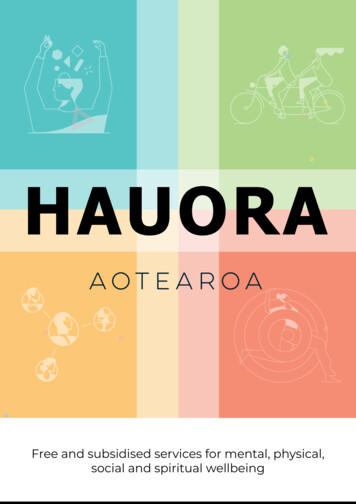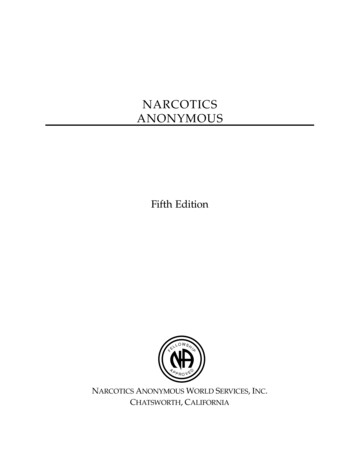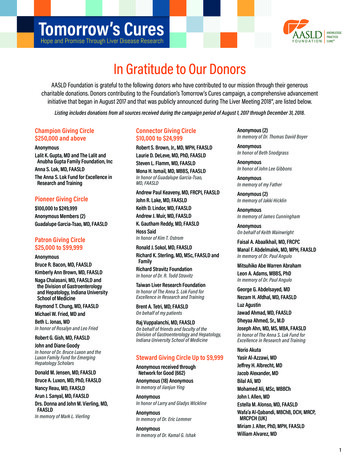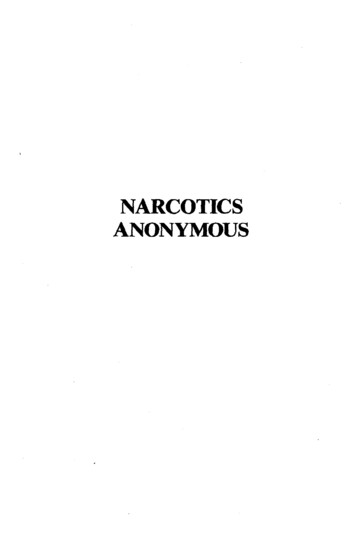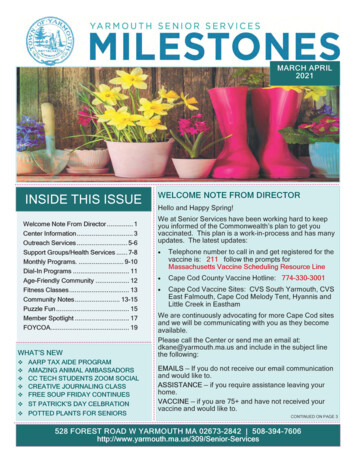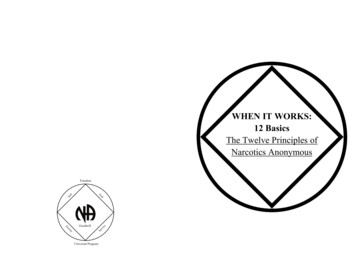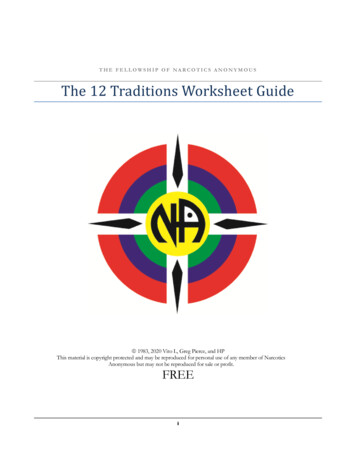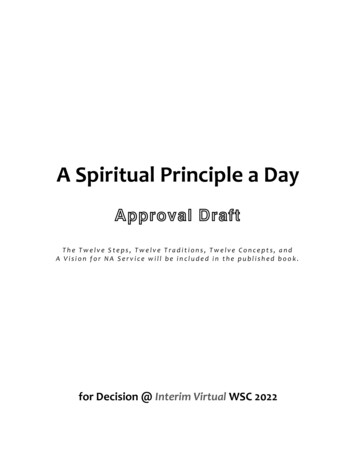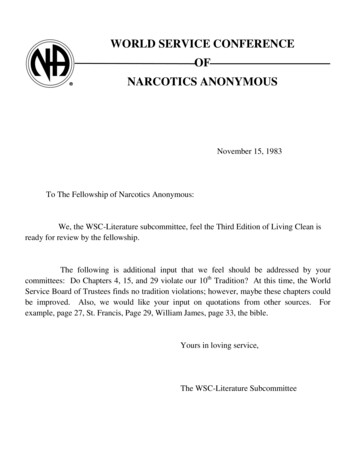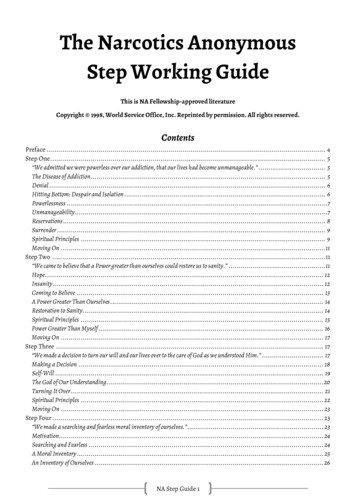
Transcription
The Narcotics AnonymousStep Working GuideThis is NA Fellowship-approved literatureCopyright 1998, World Service Office, Inc. Reprinted by permission. All rights reserved.ContentsPreface . 4Step One . 5“We admitted we were powerless over our addiction, that our lives had become unmanageable.” . 5The Disease of Addiction . 5Denial . 6Hitting Bottom: Despair and Isolation . 6Powerlessness .7Unmanageability.7Reservations . 8Surrender . 9Spiritual Principles . 9Moving On .11Step Two . 11“We came to believe that a Power greater than ourselves could restore us to sanity.” .11Hope . 12Insanity . 12Coming to Believe . 13A Power Greater Than Ourselves . 14Restoration to Sanity . 14Spiritual Principles . 15Power Greater Than Myself . 16Moving On . 17Step Three . 17“We made a decision to turn our will and our lives over to the care of God as we understood Him.” . 17Making a Decision . 18Self-Will . 19The God of Our Understanding . 20Turning It Over . 21Spiritual Principles . 22Moving On . 23Step Four . 23“We made a searching and fearless moral inventory of ourselves.” . 23Motivation . 24Searching and Fearless . 24A Moral Inventory . 25An Inventory of Ourselves . 26NA Step Guide 1
Spiritual Principles . 26The Inventory . 26Resentments . 26Feelings . 27Guilt, Shame . 27Fear . 27Relationships . 28Sex . 29Abuse . 30Assets . 31Secrets . 31Moving On . 32Step Five . 32“We admitted to God, to ourselves, and to another human being the exact nature of our wrongs.” . 32Facing Fears . 33Admitted to God . 33To Ourselves . 33And to another human being. 34The Exact Nature of Our Wrongs . 35Spiritual Principles . 35Moving On . 36Step Six . 37“We were entirely ready to have God remove all these defects of character.” . 37Entirely Ready for what? . 37To Have God Remove. . 38Our Defects of Character . 39Spiritual Principles . 39Moving On . 41Step Seven . 41“We humbly asked Him to remove our shortcomings.” . 41Preparing To Work Step Seven . 42Asking To Have Our Shortcomings Removed . 43Getting Out Of The Way . 44Spiritual Principles . 44Moving On . 45Step Eight . 45“We made a list of all persons we had harmed, and became willing to make amends to them all.” . 45The People We Harmed and How We Harmed Them . 47Making Our List . 48Becoming Willing . 49Spiritual Principles . 50Moving On . 51Step Nine . 51“We made direct amends to such people wherever possible, except when to do so would injure them or others.” . 51Amends . 52Fears and Expectations . 52Amends — Direct and Indirect . 54Forgiveness . 56Making Amends . 58Spiritual Principles . 59NA Step Guide 2
Moving On . 59Step Ten . 60“We continued to take personal inventory and when we were wrong promptly admitted it.” . 60Feeling versus Doing . 60Right and Wrong . 62How Often Should We Take A Personal Inventory? . 63A Personal Inventory . 64Spiritual Principles . 65Moving On . 66Step Eleven . 67“We sought through prayer and meditation to improve our conscious contact with God as we understood Him, praying onlyfor knowledge of His will for us and the power to carry that out.” . 67Our Own Spiritual Path . 67Prayer and Meditation. 69Conscious Contact . 70God’s Will . 71The Power to Carry That Out . 72Spiritual Principles . 72Moving On . 73Step Twelve . 74“Having had a spiritual awakening as a result of these steps, we tried to carry this message to addicts, and to practice theseprinciples in all our affairs.” . 74We Tried To Carry This Message . 74To Addicts. 77Practicing These Principles in All Our Affairs . 77Spiritual Principles . 78Moving On . 79NA Step Guide 3
PrefaceThe idea for this piece of literature came from the Narcotics Anonymous Fellowship itself. Beginning inthe early 1980s, we began receiving Twelve Step guides and step worksheets along with requests that wedevelop a standard set of guides for the NA Fellowship to use in working through the Twelve Steps.Fellowship demand propelled this project up the NA World Service Conference Literature Committee’spriority wordlists, and finally resulted in the World Service Conference directing the WSCLC to goahead with the project at WSC’95.The working title for this project for many years was the “Step Writing Guides.” However, we recognizedthat the word “writing” imposed a limitation on members who may be unable to write or may choose notto use writing as the means for working the Twelve Steps. Therefore, the title became the Step WorkingGuides.Each chapter includes both narrative and questions. The narrative is meant to provoke thought aboutthe questions but is not meant to be comprehensive. There is a difference in “voice” between thenarrative and the questions. The narrative is written in the “we” voice to promote unity about what we allhave in common: our addiction and recovery. The questions are written in the individual “I” voice so thateach member using these guides can personalize the work. The Step Working Guides is a companionpiece to It Works: How and Why. Thorough discussion of each of the Twelve Steps is contained in thatwork. Additional information about NA recovery can be found in other NA literature. If we find that anyof the terms used in this book are unfamiliar, we should feel free to make use of a dictionary.These guides are meant to be used by NA members at any stage of recovery, whether it’s our first timethrough the steps or we’ve been living with the steps as our guiding force for many years. This book isintentionally written to be relevant to newcomers and to help more experienced members develop adeeper understanding of the Twelve Steps. As NA grows in numbers, in diversity, and in strength andlongevity of clean time, we need literature that will continue to serve the needs of the fellowship1literature that “grows” along with the fellowship.However, as open and inclusive as we tried to be when writing these guides, we realized that we wouldnever be able to write something that captured every member’s experience with the steps. In fact, wewouldn’t have tried to do that, even if we thought it were possible. This book contains guides to workingthe Twelve Steps toward recovery; it does not contain recovery itself. Recovery is ultimately found ineach member’s personal experience with working the steps. You can add to these guides, delete fromthem, or use them as they are. It’s your choice.There’s probably only one inappropriate way to use these guides: alone. We can’t overemphasize theimportance of working with a sponsor in working the steps. In fact, in our fellowship, a sponsor isconsidered, first and foremost, a guide through the Twelve Steps. If you haven’t yet asked someone tosponsor you, please do so before beginning these guides.Merely reading all the available information about any of the Twelve Steps will never be sufficient tobring about a true change in our lives and freedom from our disease. It’s our goal to make the steps partof who we are. To do that, we have to work them. Hence, the Step Working Guides.Like every piece of NA literature, this was written by addicts for addicts. We hope that every memberwho uses this book will be encouraged and inspired. We are grateful to have been given the opportunityto participate in this project. Thank you for allowing us to be of service.WSC Literature Committee.NA Step Guide 4
Step One“We admitted we were powerless over our addiction, that our lives had becomeunmanageable.”A “first” of anything is a beginning, and so it is with the steps: The First Step is the beginning of therecovery process. The healing starts here; we can’t go any further until we’ve worked this step.Some NA members “feel” their way through the First Step1 by intuition; others choose to work Step Onein a more systematic fashion. Our reasons for formally working Step One will vary from member tomember. It may be that we’re new to recovery, and we’ve just fought — and lost — an exhausting battlewith drugs. It may be that we’ve been around awhile, abstinent from drugs, but we’ve discovered thatour disease has become active in some other area of our lives, forcing us to face our powerlessness andthe unmanageability of our lives once again. Not every act of growth is motivated by pain; it may just betime to cycle through the steps again1 thus beginning the next stage of our never-ending journey ofrecovery.Some of us find a measure of comfort in realizing that a disease, not a moral failing, has caused us toreach this bottom. Others don’t really care what the cause has been — we just want out!Whatever the case, it’s time to do some step work: to engage in some concrete activity that will help usfind more freedom from our addiction, whatever shape it is currently taking. Our hope is to internalizethe principles of Step One, to deepen our surrender, to make the principles of acceptance, humility,willingness, honesty, and open-mindedness a fundamental part of who we are.First, we must arrive at a point of surrender. There are many different ways to do this. For some of us,the road we travelled getting to the First Step was more than enough to convince us that unconditionalsurrender was our only option. Others start this process even though we’re not entirely convinced thatwe’re addicts or that we’ve really hit bottom. Only in working the First Step do we truly come to realizethat we are addicts, that we have hit bottom, and that we must surrender.Before we begin working the First Step, we must become abstinent — whatever it takes. If we’re new inNarcotics Anonymous and our First Step is primarily about looking at the effects of drug addiction inour lives, we need to get clean. If we’ve been clean awhile and our First Step is about our powerlessnessover some other behaviour that’s made our lives unmanageable, we need to find a way to stop thebehaviour so that our surrender isn’t clouded by continued acting out.The Disease of AddictionWhat makes us addicts is the disease of addiction — not the drugs, not our behaviour, but our disease.There is something within us that makes us unable to control our use of drugs.This same “something” also makes us prone to obsession and compulsion in other areas of our lives.How can we tell when our disease is active? When we become trapped in obsessive, compulsive, selfcentred routines, endless loops that lead nowhere but to physical, mental, spiritual, and emotionaldecay.1) What does “the disease of addiction” mean to me?2) Has my disease been active recently? In what way?3) What is it like when I’m obsessed with something? Does my thinking follow a pattern? Describe.NA Step Guide 5
4) When a thought occurs to me, do I immediately act on it without considering the consequences? Inwhat other ways do I behave compulsively?5) How does the self-centred part of my disease affect my life and the lives of those around me?6) How has my disease affected me physically? Mentally? Spiritually? Emotionally?Our addiction can manifest itself in a variety of ways. When we first come to Narcotics Anonymous, ourproblem will, of course, be drugs. Later, we may find out that addiction is wreaking havoc in our lives inany number of ways.What is the specific way in which my addiction has been manifesting itself most recently?7) Have I been obsessed with a person, place, or thing? If so, how has that gotten in the way of myrelationships with others? How else have I been affected mentally, physically, spiritually, andemotionally by this obsession?DenialDenial is the part of our disease that tells us we don’t have a disease. When we are in denial, we areunable to see the reality of our addiction. We minimize its effect. We blame others, citing the too-highexpectations of families, friends, and employers. We compare ourselves with other addicts whoseaddiction seems “worse” than our own. We may blame one particular drug. If we have been abstinentfrom drugs for some time, we might compare the current manifestation of our addiction with our druguse, rationalizing that nothing we do today could possibly be as bad as that was! One of the easiest waysto tell that we are in denial is when we find ourselves giving plausible but untrue reasons for ourbehaviour.8) Have I given plausible but untrue reasons for my behaviour? What have they been?9) Have I compulsively acted on an obsession, and then acted as if I had actually planned to act thatway? When were those times?10) How have I blamed other people for my behaviour?11) How have I compared my addiction with others’ addiction? Is my addiction “bad enough” if I don’tcompare it to anyone else’s?12) Am I comparing a current manifestation of my addiction to the way my life was before I got clean?Am I plagued by the idea that I should know better?13) Have I been thinking that I have enough information about addiction and recovery to get mybehaviour under control before it gets out of hand?14) Am I avoiding action because I’m afraid I will be ashamed when I face the results of my addiction?Am I avoiding action because I’m worried about what others will think?Hitting Bottom: Despair and IsolationOur addiction finally brings us to a place where we can no longer deny the nature of our problem. All thelies, all the rationalizations, all the illusions fall away as we stand face-to-face with what our lives havebecome. We realize we’ve been living without hope. We find we’ve become friendless or so completelydisconnected that our relationships are a sham, a parody of love and intimacy. Though it may seem thatall is lost when we find ourselves in this state, the truth is that we must pass through this place before wecan embark upon our journey of recovery.NA Step Guide 6
15) What crisis brought me to recovery?16) What situation led me to formally work Step One?17) When did I first recognize my addiction as a problem? Did I try to correct it? If so, how? If not, whynot?PowerlessnessAs addicts, we react to the word “powerless” in a variety of ways. Some of us recognize that a moreaccurate description of our situation simply could not exist and admit our powerlessness with a sense ofrelief. Others recoil at the word, connecting it with weakness or believing it to indicate some kind ofcharacter deficiency. Understanding powerlessness — and how admitting our own powerlessness isessential to our recovery — will help us get over any negative feelings we may have about the concept.We are powerless when the driving force in our life is beyond our control. Our addiction certainlyqualifies as such an uncontrollable, driving force. We cannot moderate or control our drug use or othercompulsive behaviours, even when they are causing us to lose the things that matter most to us. Wecannot stop, even when to continue will surely result in irreparable physical damage. We find ourselvesdoing things that we would never do if it weren’t for our addiction; things that make us shudder withshame when we think of them. We may even decide that we don’t want to use, that we aren’t going touse, and realize we are simply unable to stop when the opportunity presents itself.We may have tried to abstain from drug use or other compulsive behaviours — perhaps with somesuccess — for a period of time without a program, only to find that our untreated addiction eventuallytakes us right back to where we were before. In order to work the First Step, we need to prove our ownindividual powerlessness to ourselves on a deep level.18) Over what, exactly, am I powerless?19) I’ve done things while acting out on my addiction that I would never do when focusing on recovery.What were they?20) What things have I done to maintain my addiction that went completely against all my beliefs andvalues?21) How does my personality change when I’m acting out on my addiction? (For example: Do I becomearrogant? Self-centred? Mean-tempered? Passive to the point where I can’t protect myself?Manipulative? Whiny?)22) Do I manipulate other people to maintain my addiction? How?23) Have I tried to quit using and found that I couldn’t? Have I quit using on my own and found that mylife was so painful without drugs that my abstinence didn’t last very long? What were these timeslike?24) How has my addiction caused me to hurt myself or others?UnmanageabilityThe First Step asks us to admit two things: one, that we are powerless over our addiction; and two, thatour lives have become unmanageable. Actually, we would be hard pressed to admit one and not theother. Our unmanageability is the outward evidence of our powerlessness. There are two general typesof unmanageability: outward unmanageability, the kind that can be seen by others; and inner, orpersonal, unmanageability.NA Step Guide 7
Outward unmanageability is often identified by such things as arrests, job losses, and family problems.Some of our members have been incarcerated. Some have never been able to sustain any kind ofrelationship for more than a few months. Some of us have been cut off from our families, asked neveragain to contact them.Inner or personal unmanageability is often identified by unhealthy or untrue belief System
The idea for this piece of literature came from the Narcotics Anonymous Fellowship itself. Beginning in the early 1980s, we began receiving Twelve Step guides and step worksheets along with requests that we develop a standard set of guides for the NA Fellowship to use in working through the Twelve Steps.
